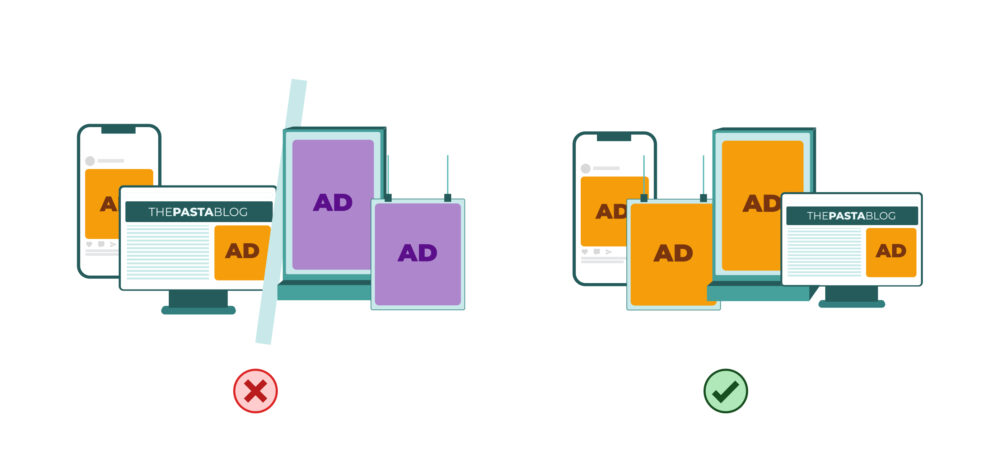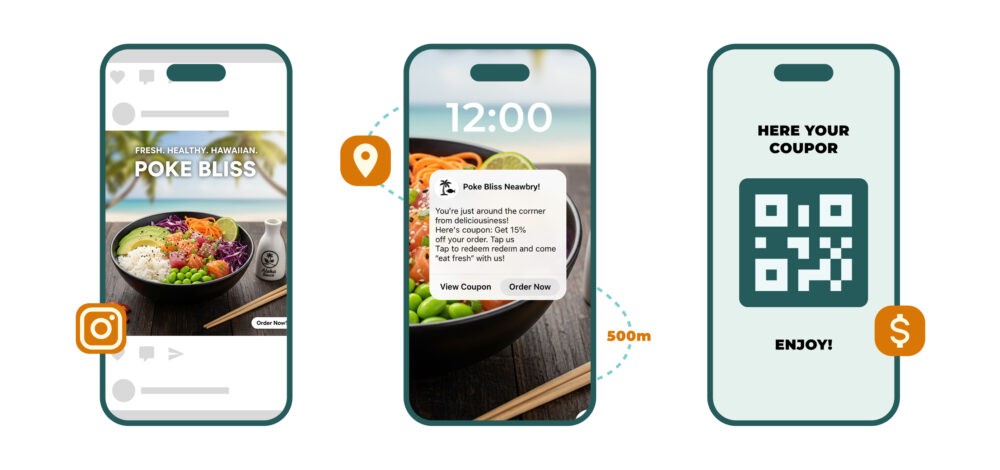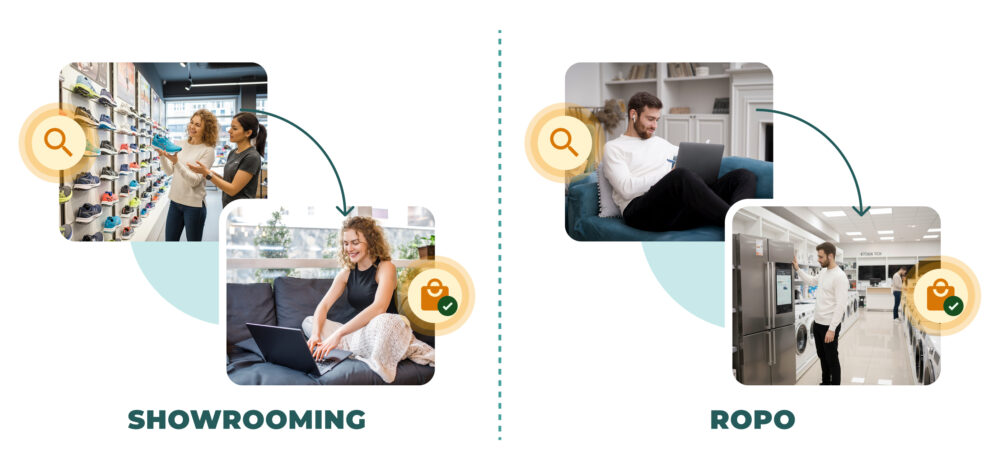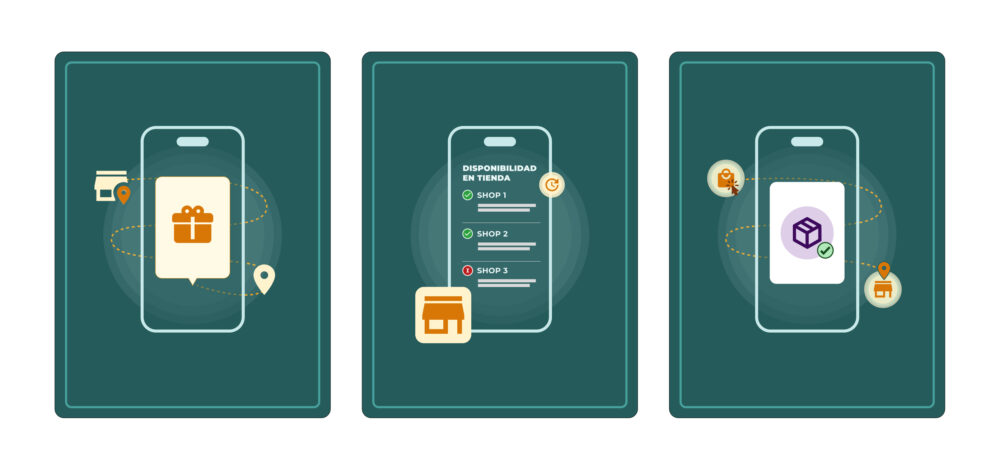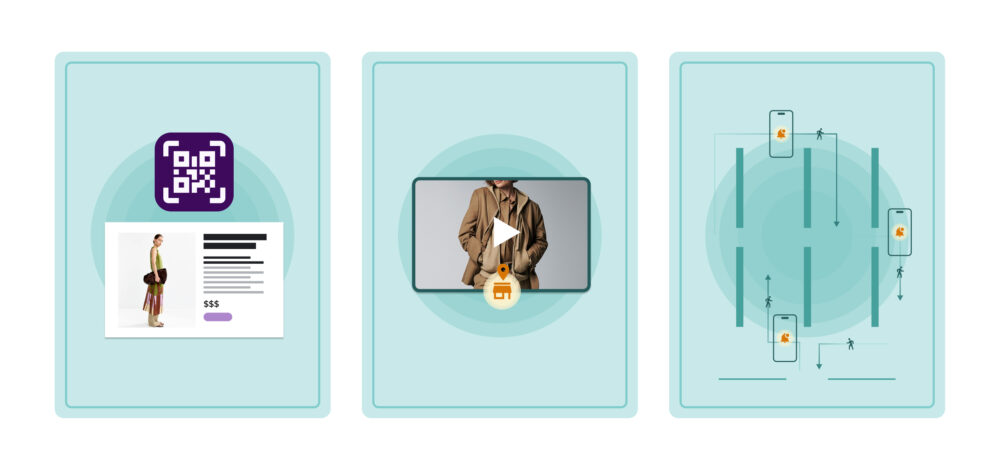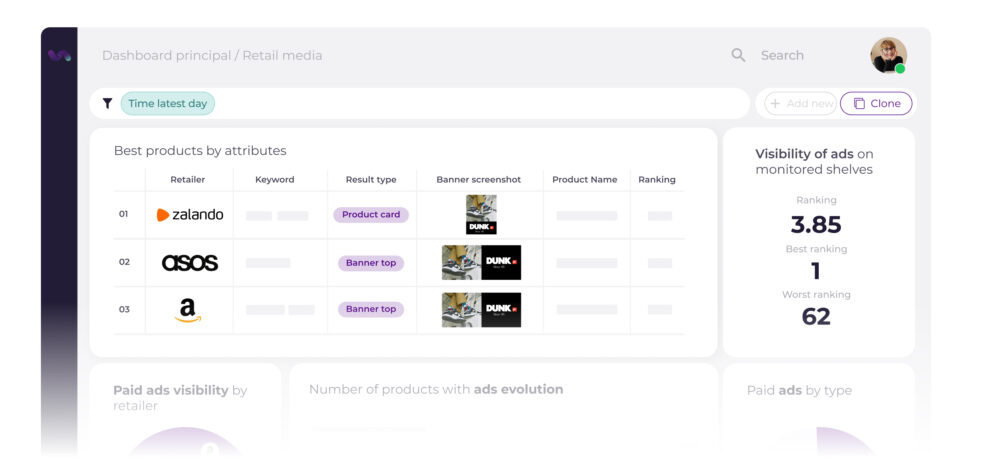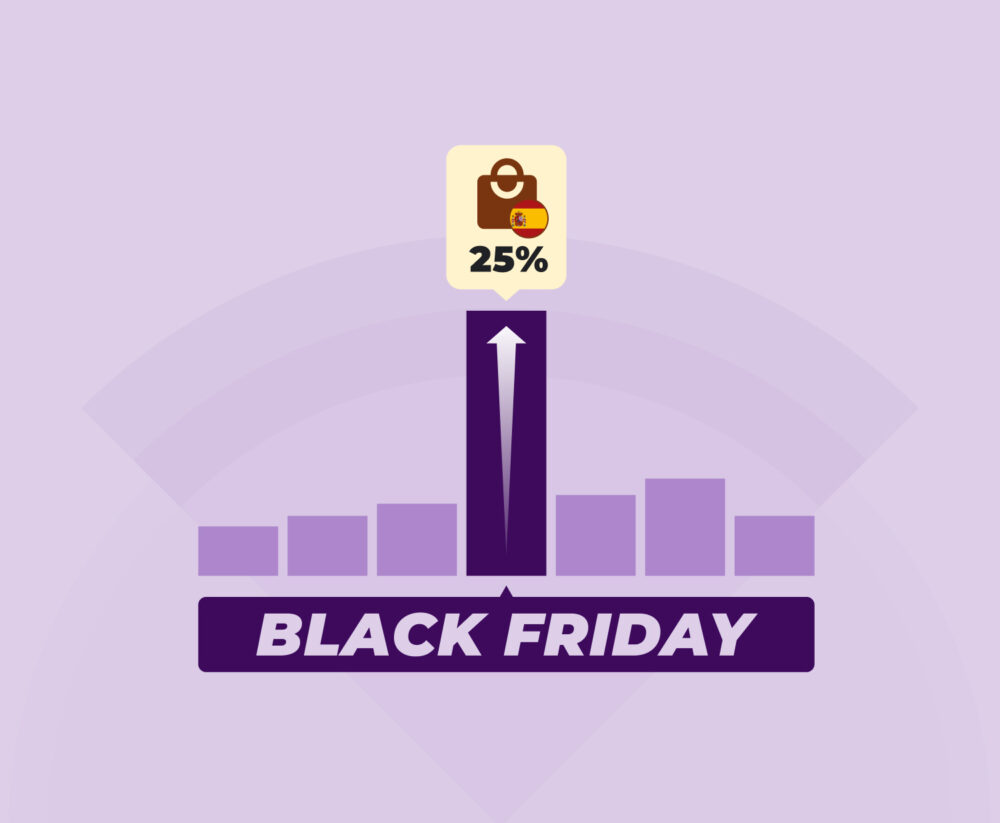Retail Media 360: How to integrate offline and online channels to build effective campaigns
A customer walks down the aisle of an electronics shop, holding her mobile in one hand while examining a coffee machine on the shelf. She quickly looks up product reviews, compares the price with other online stores, and watches a YouTube tutorial on how to use it. Five minutes later, she adds the coffee machine to her physical shopping basket and heads to the checkout. This situation, far from being exceptional, reflects the reality of today’s shopper.
Up to 87% of shoppers use their mobile phones inside a physical shop to compare prices or look for reviews. This figure reveals an undeniable reality: the line that separated physical and digital commerce has vanished. Consumers no longer distinguish between online and offline; for them, there is only one shopping experience.
The Broken Frontier Between Online and Offline
This hybrid behaviour poses a fundamental problem for brands and retailers. Many companies continue to manage their advertising campaigns in separate silos. One team handles social media and digital advertising, while another deals with in-store promotions and point-of-sale displays. This artificial division leads to the loss of valuable information about the complete customer journey, wasted resources, and disconnected experiences that confuse the consumer.
The true power of Retail Media is unleashed when brands unify the digital and physical worlds, creating an integrated experience where each channel feeds and enhances the other. It is about creating a “phygital” experience, a hybrid that leverages the best of both worlds to offer a seamless shopping journey.
What Does Integrating Offline and Online Channels in Retail Media Mean?
The integration of channels in Retail Media involves designing advertising strategies that work in a coordinated manner in both digital and physical environments. Instead of parallel campaigns that do not communicate with each other, we are talking about creating a unified advertising ecosystem where data, messages, and objectives flow freely between all customer contact points.
Within the online channel, we find spaces such as retailers’ websites, mobile applications, social media, programmatic advertising, and ads on e-commerce platforms. In the offline channel, we have physical shops, posters and displays at the point of sale, digital out-of-home advertising, and in-person events.
Integration means that a person who sees an ad on Instagram about a special offer receives a geolocated reminder when they pass near the physical shop, and they can redeem that promotion both online and in person. Or that someone browsing a product in the shop can scan a QR code and immediately access more information, reviews from other buyers, and tutorials, all without leaving their shopping experience.
This synchronisation requires appropriate technology, unified data and, above all, a change in mindset that places the customer at the centre, recognising that their shopping experience transcends the traditional barriers between channels.
The Omnichannel Customer: The True Protagonist
At the heart of this revolution is the omnichannel customer. This consumer uses multiple channels simultaneously and in an integrated way, seeking a shopping experience that is agile, personalised, and frictionless. They demand coherence and continuity at all points of contact with the brand. And they are loyal to those that provide a positive and unified experience.
To understand this new consumer, it is essential to analyse two models of behaviour that define the interaction between the online and offline worlds:
- ROPO (Research Online, Purchase Offline): This model describes customers who research products on the internet but complete their purchase in a physical shop. They look for technical specifications, read reviews, and compare prices and features from the comfort of their home. But they prefer to see, touch, or try the product before buying it. They also value the immediacy of taking the product home the same day or receiving personalised advice from a salesperson. Sectors such as electronics, furniture, and fashion have high rates of ROPO behaviour.
- Showrooming: At the opposite end of the spectrum, some consumers visit physical shops to examine products, try them out, and ask questions to salespeople, but they complete the purchase online. The reasons vary: they are looking for better prices, want to pay with specific methods, prefer the convenience of having the product delivered to their home, or simply want more time to decide. This phenomenon initially worried physical retailers, who saw their shops turning into “showrooms” for online platforms.
Both behaviours demonstrate the importance of being present at all points of contact in the customer journey. A brand that only focuses on one of the two worlds is missing a great opportunity to connect with its consumers. And, ultimately, to sell.
Benefits of Channel Integration
Unifying Retail Media strategies across online and offline channels generates tangible advantages for both brands and consumers:
Improved customer experience
When all channels offer coherent messages, the customer perceives professionalism and trust. Imagine receiving a 20% offer on face cream via email, arriving at the shop, and discovering that the promotion does not exist there. Or that the product shown online is not available at the nearest establishment. These disconnections generate frustration and mistrust.
On the contrary, an integrated experience where promotions, stock, and product information are synchronised across channels creates a sense of transparency and service that strengthens the relationship with the brand.
Optimisation of advertising return on investment
By coordinating campaigns across channels, brands avoid advertising saturation and budget waste. Unified data allows for an understanding of which channel combinations generate the best results.
For example, a campaign may discover that social media ads work better when complemented by advertising on digital screens near the shops. Or that sending personalised digital coupons after a visit to the shop significantly increases repeat purchases. This complete view of the customer journey allows for smarter allocation of the advertising budget, investing more in the combinations that truly drive sales.
Strengthening loyalty
Personalised and relevant experiences at all points of contact build long-term loyalty. When a brand remembers a customer’s preferences both online and offline, when it recognises their purchase history regardless of the channel used, and when it offers useful recommendations based on their complete behaviour, that customer feels that the brand truly knows and values them.
This emotional connection transcends a simple commercial transaction and creates brand advocates who not only buy repeatedly but also actively recommend the company to others.
Practical Strategies to Unify your Campaigns
Channel integration is not an abstract concept, but a series of concrete actions that brands can implement. Let’s look at the most effective tactics organised according to the direction of customer flow.
Bridges from Online to Offline
- Geotargeting (geographic segmentation): This technique uses the location of the user’s mobile device to show them relevant ads when they are near a physical shop. For example, a coffee shop chain can send a notification with a special offer when a regular customer passes by the premises. The key is balance: the right frequency and relevance generate visits, but an excess of notifications becomes invasive.
- Local stock in digital ads: More and more advertising platforms allow for displaying the availability of products in nearby shops directly in online ads. Google Shopping, Facebook, and Instagram offer this functionality. This transparency reduces the frustration of visiting a shop only to find that the desired product is out of stock.
- Click & Collect (buy online, pick up in-store): This service combines the convenience of buying online with the immediacy of picking up the product in the shop, often on the same day and without delivery costs. For brands, it represents a dual opportunity: it facilitates online conversion and generates traffic to physical shops, where customers frequently make additional purchases. Advertising campaigns should highlight this service as a benefit, especially for products that the customer needs quickly or when important dates are approaching.
Bridges from Offline to Online
- QR codes: Although they have been around for years, QR codes have experienced a massive resurgence and now function as natural bridges between the physical and digital worlds. Placed strategically on product packaging, in-store posters, or on displays, they allow customers to instantly access additional information, reviews from other buyers, user tutorials, recipes, or even augmented reality that shows how a piece of furniture would look in their home. They can also be used to redeem exclusive promotions or subscribe to loyalty programmes.
- Digital screens (DOOH): Digital out-of-home advertising has evolved enormously. Screens in shops, shopping centres, and public spaces can now display dynamic content. This content changes according to the time of day, the weather, or even who is watching (using non-invasive recognition technology that identifies general demographic patterns without identifying individuals). These screens can promote products, display user-generated content, or invite passers-by to interact by scanning codes, visiting websites, or downloading apps. The measurement of their effectiveness has also improved, allowing for an understanding of how many people saw the ad and what actions they took afterwards.
- Beacons and in-store Wi-Fi: Beacons are small devices that emit Bluetooth signals detectable by customers’ mobiles when they enter a shop. With the user’s permission, they can send personalised notifications based on their exact location within the establishment. For example, a customer who bought coffee last month is walking down the coffee aisle. They might receive a special offer for their favourite brand. The shop’s free Wi-Fi adds value for the customer. In addition, it allows for the collection of anonymous data about browsing behaviour within the establishment. It also helps to identify the most visited points and to optimise the layout of products and campaigns.
The Great Challenge: Measurement and Attribution
One of the biggest challenges in channel integration is identifying which point of contact influenced the purchase decision. It could also be a combination of several points. For example, a customer sees an ad on social media. They then receive a promotional email. Later, they see a digital billboard near the shop. Finally, they purchase the product in the physical establishment. In these cases, it is complex to determine which action deserves credit for the conversion.
Traditional attribution models fall short in this omnichannel environment. Therefore, the current trend is to adopt platforms that integrate and unify data collected both online and offline, allowing for a complete view of the customer journey: from the first advertising impact to the final purchase, whether on the web or in the physical shop. In this context, the standardisation of metrics and the use of clean rooms —secure spaces that allow data to be analysed without compromising privacy— are emerging as key elements for the future of measurement in Retail Media.
Although achieving perfect measurement is probably impossible, brands that invest in improving their tracking and analysis capabilities gain significant competitive advantages, as they can continuously optimise their strategies based on real consumer behaviour data. In this process, collaboration between brands and distributors is essential, as both possess complementary pieces of the complex customer data puzzle.
Conclusion: Beyond Channels — Towards a Unified Experience
Integrating the offline and online worlds has become the key for Retail Media to generate true value. Today’s consumer does not think in terms of channels: they seek consistent, useful, and personalised experiences, regardless of where they interact with the brand. Those companies that understand this dynamic are achieving better conversion levels, building stronger relationships, and gaining a more complete view of purchasing behaviour.
Understanding the role that each point of contact plays—and translating data into strategies that bring coherence and profitability—is now the real challenge, rather than merely being present at multiple touchpoints. Meanwhile, the evolution of Retail Media demands a shift from simple technological integration to a genuine cultural transformation: teams, platforms, and formats must work without borders to offer a fluid and meaningful journey to the customer.
The future will belong to the brands and distributors capable of breaking down silos and creating seamless phygital experiences, where the physical and the digital merge into a single narrative. Technology and data are the instruments; strategic vision and the ability to adapt are the true engines of change. Ultimately, leading tomorrow’s commerce will depend on who manages to understand that the customer experience is, today, at the centre of every successful strategy.

